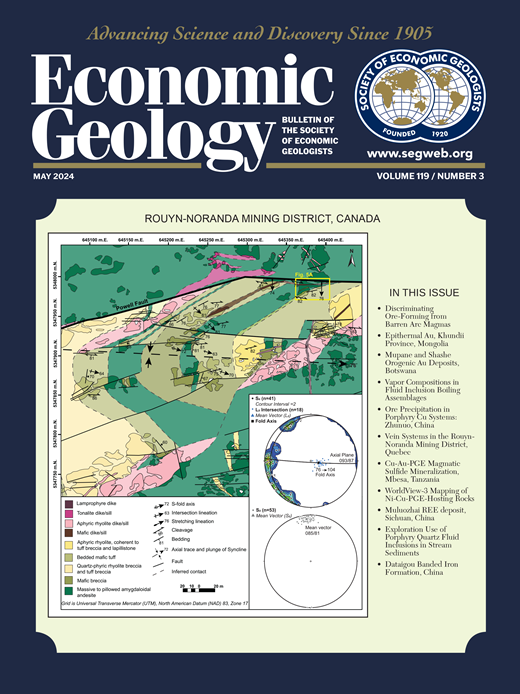埃及Sukari金矿床:地球化学和年代学对矿石成因的制约及对区域找矿的指示意义
IF 4.9
1区 地球科学
Q1 GEOCHEMISTRY & GEOPHYSICS
引用次数: 0
摘要
埃及东部沙漠Sukari金矿床(>15 Moz Au)赋存于变形花岗岩体(Sukari闪晶岩体)中,主要赋存于含硫化物的石英(±碳酸盐)脉和强烈硫化硅绢云母化围岩的纵横交错网络中。苏卡利侵入新元古代构造增生杂岩的侵位受NE- nne向斜断裂系统控制,该系统与深部正花构造有关。由于对金矿化与寄主岩石之间的关系了解甚少,一个健全的成因模型受到了阻碍。本文对苏卡里岩体3个样品进行了锆石U-Pb年龄测定,确定了结晶年龄为~695±2 Ma。成矿带热液绢云母的40Ar/39Ar年龄为~625±3 Ma,与该区主要的左旋坳陷发生时间一致。金石英脉的s形形态和丰富的亚水平张拉裂隙以及广泛的角化和再结晶特征表明,石英脉是在脆性-韧性转变的重新缩短和发掘过程中形成的。岩石学和微x射线荧光(µXRF)研究表明,浸染金和硫化物主要局限于石英脉的花柱带中,通常与绢云母和碳酸盐蚀变有关。早、晚期黄铁矿的振荡和扇形分带、不规则富砷带和截断反映了温度和成矿机制的变化,不同黄铁矿代间As/S和Co/Ni比值的变化体现了这一变化。激光烧蚀-电感耦合等离子体质谱分析精确地确定了黄铁矿中金和砷含量的协方差,但微裂缝中的游离磨铣金包裹体始终具有含汞的电子成分,描绘了不同的成矿阶段。矿石流体δ34SH2s值为-1.9 ~ -3.0‰,由δ34S值几乎相同的金伴生黄铁矿和毒砂组合模拟,表明可能存在单一硫源。或者,多源硫可能通过与碳质围岩的流体反应进行了广泛的混合和平衡。金的沉积是由流体pH和fO2的突变引起的。对于未来勘探的启示是,该地区沿广泛的变形带,应变梯度最大的花岗岩类体附近可能是极有前景的目标,特别是在绢云母-碳酸盐岩±石墨蚀变的地方。本文章由计算机程序翻译,如有差异,请以英文原文为准。
The Sukari Gold Deposit, Egypt: Geochemical and Geochronological Constraints on the Ore Genesis and Implications for Regional Exploration
The Sukari gold deposit (>15 Moz Au) in the Eastern Desert of Egypt is hosted by a deformed granitoid stock (Sukari tonalite-trondhjemite intrusion) and mainly occurs as a network of crosscutting sulfide-bearing quartz (± carbonate) veins and intensely sulfidized-silicified-sericitized wall rock. Emplacement of the Sukari intrusion into a tectonized Neoproterozoic accretionary complex was controlled by a system of NE- to NNE-trending oblique faults that are related to a deep-seated positive flower structure. A robust genetic model has been hampered by the poorly understood relationships between gold mineralization and host rocks. In this study, zircon U-Pb ages of three samples from the Sukari intrusion define a crystallization age of ~695 ± 2 Ma. In contrast, hydrothermal sericite from the ore zone yields an 40Ar/39Ar age of ~625 ± 3 Ma, which coincides with the onset of major sinistral transpression in the region.
Features including sigmoidal morphology of gold quartz veins and abundant subhorizontal tension gashes alongside widespread brecciation and recrystallization suggest that quartz veining occurred during renewed shortening and exhumation through the brittle-ductile transition. Petrographic and micro-X-ray fluorescence (µXRF) studies indicate that disseminated gold and sulfides, commonly associated with sericite and carbonate alteration, are mostly confined to stylolitic bands in the quartz veins. Oscillatory and sector zoning patterns, irregular As-rich bands, and truncations between early- and late-genetic pyrites reflect variations in temperature and mechanism of ore deposition, demonstrated by variable As/S and Co/Ni ratios in the different pyrite generations. Laser ablation-inductively coupled plasma-mass spectrometry analysis pinpoints the covariance of gold and arsenic contents in pyrite, but free milling gold inclusions in microfractures consistently have a mercury-bearing electrum composition, depicting different ore formation stages.
Ore fluids with δ34SH2s values of –1.9 to –3.0‰, modeled from gold-associated pyrite and arsenopyrite assemblages with nearly identical δ34S values, suggest a likely single source of sulfur. Alternatively, multisourced sulfur could have extensively mixed and equilibrated by fluid reaction with carbonaceous wall rock. Gold deposition was triggered by abrupt changes in fluid pH and fO2. As an implication for future exploration, sites of maximized strain gradients adjacent to granitoid bodies along extensive transpression zones in the district could be highly prospective targets, particularly where imprinted by sericite-carbonate ± graphite alteration.
求助全文
通过发布文献求助,成功后即可免费获取论文全文。
去求助
来源期刊

Economic Geology
地学-地球化学与地球物理
CiteScore
10.00
自引率
6.90%
发文量
120
审稿时长
6 months
期刊介绍:
The journal, now published semi-quarterly, was first published in 1905 by the Economic Geology Publishing Company (PUBCO), a not-for-profit company established for the purpose of publishing a periodical devoted to economic geology. On the founding of SEG in 1920, a cooperative arrangement between PUBCO and SEG made the journal the official organ of the Society, and PUBCO agreed to carry the Society''s name on the front cover under the heading "Bulletin of the Society of Economic Geologists". PUBCO and SEG continued to operate as cooperating but separate entities until 2001, when the Board of Directors of PUBCO and the Council of SEG, by unanimous consent, approved a formal agreement of merger. The former activities of the PUBCO Board of Directors are now carried out by a Publications Board, a new self-governing unit within SEG.
 求助内容:
求助内容: 应助结果提醒方式:
应助结果提醒方式:


